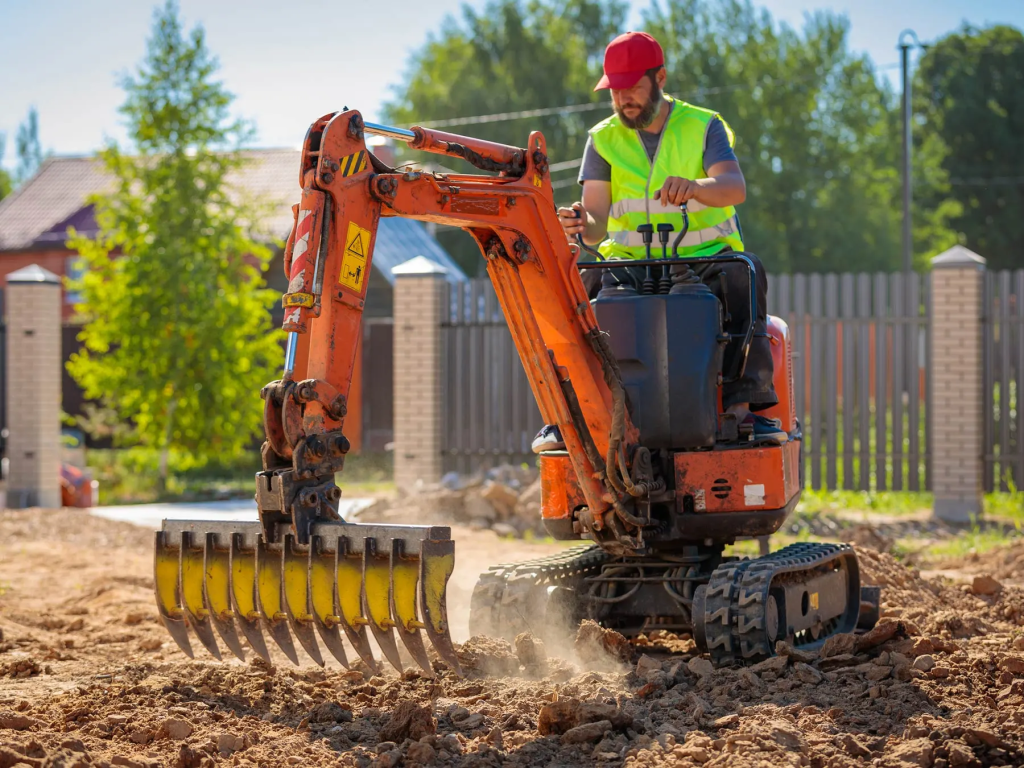
Mini excavator, also called compact excavator, one of numerous, has a more manageable, nimble, and adaptable chassis that makes it ideal for a variety of tasks. These lightweight machines weigh between 2,000 and 20,000 pounds, and you can equip them with a wide range of attachments to do a wide range of tasks, from snowplowing to demolition and excavation.
This advice can be useful if you believe that you might require a tiny excavator on the job site. We define a small excavator, discuss their adaptability, provide safety tips, show you how to use one safely, and help you choose the best one for your next job.
Mini Excavator Parts
It’s important to know what each part of a mini excavator does and how it contributes to the operation of a mini excavator. You should be familiar with these common excavator parts.
- Undercarriage: This is the bottom section of the excavator. It’s the portion of the machine that allows the vehicle to move about.
- Boom: This is the part of the apparatus that is attached to the cab.
- Arm: The arm is supported by the boom and is sometimes called a dipper or stick.
- Bucket: The bucket is at the end of the arm that scoops out the earth.
- Cab: The cab is the part of the excavator where the operator sits, controlling the vehicle.
- Excavator tracks: These are the steel-reinforced rubber tracks that move the machine.
- Idlers: These are large metal wheels within the undercarriage that keep the tracks running correctly.
- ROPS: The rollover protective structure, or ROPS, protects the operator in the case of a rollover.
- Counterweight: This counterbalances the excavator when its center of gravity begins to shift when digging, lowering the risk of tipping.
- Main control valve: This valve controls things like oil pressure and the power to hydraulic systems.
Operating a Mini Excavator
Before using any construction equipment on the job site, you should always consult your operation handbook. However, the following are some crucial guidelines for using a mini excavator safely and effectively:
- Understand the Controls and Functionality
- Familiarize yourself with the location and function of all the controls, including the joysticks, pedals, and switches.
- Become proficient in maneuvering the machine, operating the boom, arm, and bucket, and understanding the hydraulic system.
- Consult the operator’s manual and seek training if needed to ensure you have a thorough understanding of the mini excavator’s capabilities and limitations.
- Assess the Work Site Conditions
- Carefully inspect the job site, identifying any potential hazards, such as overhead power lines, buried utilities, uneven terrain, or soft ground conditions.
- Adjust your operating techniques and work plan accordingly to navigate these challenges safely and efficiently.
- Ensure the mini excavator is positioned on a stable, level surface to maintain balance and control during operation.
- Optimize Digging and Loading Techniques
- Develop a smooth, controlled digging motion, using the boom, arm, and bucket in a coordinated manner.
- Position the mini excavator to minimize the need for excessive swinging, which can compromise stability and productivity.
- When loading materials, be mindful of the machine’s lift capacity and distribute the load evenly to maintain balance.
- Prioritize Safety
- Always wear appropriate personal protective equipment (PPE), including a hard hat, high-visibility vest, safety glasses, and steel-toed boots.
- Establish clear communication protocols with ground personnel, using hand signals or radios to coordinate movements and avoid accidents.
- Familiarize yourself with the mini excavator’s stability and tipping limits, and never exceed the manufacturer’s recommended capacities.
- Practice Efficient Maneuvering
- Develop proficiency in navigating tight spaces, making tight turns, and working in confined areas.
- Use the mini excavator’s compact size and superior maneuverability to your advantage, allowing you to access areas that larger machines cannot.
- Practice smooth, controlled movements to maintain stability and minimize wear and tear on the machine.
- Perform Regular Maintenance and Inspections
- Adhere to the manufacturer’s recommended maintenance schedule, including regular checks of fluid levels, filters, and critical components.
- Promptly address any issues or unusual sounds, as ignoring them can lead to more significant problems down the line.
- Keep the mini excavator clean and well-maintained to ensure optimal performance and longevity.
By mastering these tips for operating a mini excavator, you can maximize the efficiency, productivity, and safety of your construction, landscaping, or utility projects. Remember, proper training, situational awareness, and a commitment to maintenance are the keys to becoming a skilled and confident mini excavator operator.